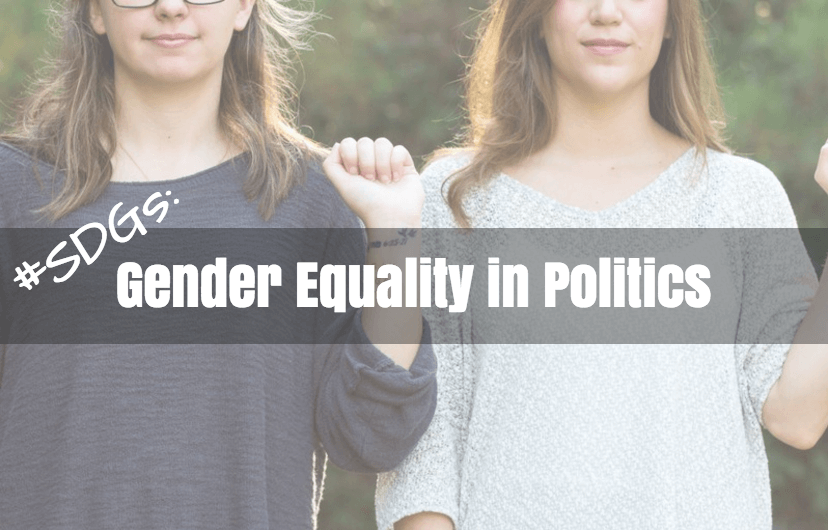One of the UN developmental goals is to achieve gender equality by 2030, including in politics. As an international body, the UN created the 2030 sustainable developmental goals for all nations inclusively. In the UN’s pursuit of these goals, it is recognized that these challenges are surmountable with unity and vigilance.
Gender Equality sub-goal 5.5 reads:
- Ensure women’s full and effective participation and equal opportunities for leadership at all levels of decision-making in political, economic and public life
Understanding the aims of this goal requires looking at what it entails, how it is connected to the other sub-goals of gender equality, and what can be done to progress towards gender equality by 2030. Although the sub-goal is rather broad, I will mainly focus on the political equality as one aspect. However, most of my statements and arguments can be applied to any leadership or decision-making role.
It is crucial that equality of opportunity for leadership is mentioned rather than representation in leadership roles. Although representation is the first step, equality is much more powerful and significant. However, equality does not mean that there needs to be a 50% allocation of seats for women. Women’s political participation is not exclusive to being elected to a government office. For example, attending a parent school council meeting or volunteering for an election campaign can also be considered acts of political participation. The UN’s mention of equal opportunity for leadership roles does not mean to say that women should be handed roles they are not qualified for, but rather to acknowledge the need for a gender equal playing field in leadership opportunities. The broad wording of the goal, including terms like “participation” and “opportunities for leadership” is important because it not only implies that women should hold elected office, but also that women should have an equal part, participating in every step of the decision making process. The equality for political opportunities include the ability for women to participate politically and the lack of barriers to their political participation.
In the UN’s sustainable development goal of gender equality, they list 5 other sub-goals to further qualify this goal and many of them are connected to one another.
5.1 End all forms of discrimination against all women and girls everywhere
5.2 Eliminate all forms of violence against all women and girls in the public and private spheres, including trafficking and sexual and other types of exploitation
5.3 Eliminate all harmful practices, such as child, early and forced marriage and female genital mutilation
5.4 Recognize and value unpaid care and domestic work through the provision of public services, infrastructure and social protection policies and the promotion of shared responsibility within the household and the family as nationally appropriate
5.5 Ensure women’s full and effective participation and equal opportunities for leadership at all levels of decision-making in political, economic and public life
5.6 Ensure universal access to sexual and reproductive health and reproductive rights as agreed in accordance with the Programme of Action of the International Conference on Population and Development and the Beijing Platform for Action and the outcome documents of their review conferences
5.a Undertake reforms to give women equal rights to economic resources, as well as access to ownership and control over land and other forms of property, financial services, inheritance and natural resources, in accordance with national laws
5.b Enhance the use of enabling technology, in particular information and communications technology, to promote the empowerment of women
5.c Adopt and strengthen sound policies and enforceable legislation for the promotion of gender equality and the empowerment of all women and girls at all levels”
Goals 5.a and 5.4 are largely related to the goal I focus on in this article (5.5 on political gender equality) because finances often hinder women’s ability to be politically active. In an IPU report, a survey discovered that the challenges for increasing women’s entry into politics are two fold, including gender roles and finances. Running for office, in many countries, requires money and time. The length of the campaign will vary depending on the country however, in most cases, a candidate will have to take time off work. The unavoidable reality of taking time off work is a barrier for women especially because of the gender wage gap and the traditional women’s work at home. The gender wage gap is apparent because it implies that women are getting payed less than men and may not have the ability to take time off. Although the gender wage gap is a complex and significant problem, women’s equality of political opportunity is tied to it, without equality economically we face more challenges to equal political opportunity. Secondly, women are often doing more work at home in combination to their jobs. The inequality present in this statement alone means women have less time than men to engage in political conversations, research political topics, and most crucially, get involved politically. The report by IPU agrees that the success of these goals is interconnected with other sub-groups as “the further perseverance to all of the goals associated with gender equality will inherently contribute to political gender equality”.These gender-based economic inequalities, the gender wage gap and women working more at home, present difficulties for obtaining full political equality.
People seem to be in agreement with the UN, women’s political participation and opportunities are not just essential but also add diversity to the political scene. Over 90% of those surveyed in the IPU report “agreed that women bring different views, talents, and perspectives”. Further, the IPU report notes that women in politics are more likely to take a progressive approach on women’s issues such as gender-based violence and gender equality legislation. The IPU report concurs that women, however, must work in partnership with men to achieve greater gender equality in parliament and policy since men often hold decision making positions.
Gender equality issues are interconnected with other development issues and feminists often take differentiating arguments for the next steps. Some feminists argue that the patriarchal structures within politics needs to be abolished for complete liberation. This position argues that the structure of the systems is inherently unequal because it was founded by men and on principles that preserve power and privilege structures. Others argue that the solution to political gender equality lies in reserving half of the seats in political office for women. The structures of a seat allotment system vary depending on the electoral and institutional structures but overall, it attains the goal. The seat allocation strategy has been tried and tested in a few countries. For example, India allocates a third of the government seats to women. There is no one specific solution to completely achieve political gender equality for participation and opportunity because these categories are broader than just institutional offices and interconnect with other development and gender issues.
As a college student what can you do?
For women and those who identify as nonbinary, don’t hesitate to apply for leadership positions. Even if you do not get a high position, keep working towards it and apply again. Invest in yourself by improving your skill set, taking time for self care, and making the most of any opportunities that arise. Some examples of opportunities to exercise leadership in college include running for a position with Student’s Union, joining a school club, volunteering, applying for internships, participating in protests, and joining community groups.
For men, treat women as equals and allow their voices and ideas to have space. Although this may seem like common sense, too often women get interrupted by men in leadership positions. Essentially, ensuring women feel welcome to share their views and ideas will inherently help more women join in. Goals of gender equality necessarily require the allyship of men, too.
Gender equality is not something the world can achieve overnight, hence why the UN has set these SDGs for 2030. The IPU report notes that “differences are strength, men in those positions must see their female counterparts as equally capable and talented”. Moreover, women must see themselves as “equally capable and talented”. These two corresponding elements of women’s empowerment and men’s allyship are the crucial mindsets that need to be established in decision-making offices. The path and steps to take towards achieving the 2030 SDGs are not concrete or definite. By acknowledging the inequalities that exist for women, the UN has taken the first step to setting the bar for all countries to work towards. Major and minor improvements towards gender equality in every sector and the interconnected progress towards other developmental goals are viable first steps towards political gender equality as stated in sub-goal 5.5.
[divider]
Sources cited
UN SDG Website: http://www.un.org/sustainabledevelopment/sustainable-development-goals/
Report: http://www.ipu.org/PDF/publications/equality08-overview-e.pdf



